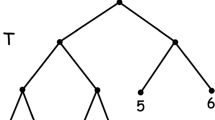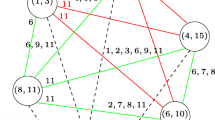Abstract
A theorem is proved stating that the set of all “minimax links”, defined as links minimizing, over paths, the maximum length of links in any path connecting a pair of objects comprising nodes in an undirected weighted graph, comprise the union of all minimum spanning trees of that graph. This theorem is related to methods of fitting network models to dissimilarity data, particularly a method called “Pathfinder” due to Schvaneveldt and his colleagues, as well as to single linkage clustering, and results concerning the relationship between minimum spanning trees and single linkage hierarchical trees.
Similar content being viewed by others
References
Dearholt, D. W., & Schvaneveldt, R. W. (1990). Properties of Pathfinder networks. In R. W. Schvaneveldt (Ed.),Pathfinder associative networks: Studies in knowledge organization (pp. 1–30). Norwood, NJ: Ablex.
Gower, J. C., & Ross, G. J. S. (1969). Minimum spanning trees and single linkage cluster analysis.Applied Statistics, 18, 54–64.
Hartigan, J. A. (1975).Clustering algorithms. New York: John Wiley & Sons.
Hutchinson, J. W. (1981). Network representations of psychological relations. Unpublished doctoral dissertation, Stanford University.
Hutchinson, J. W. (1989). NETSCAL: A network scaling algorithm for non-symmetric proximity data.Psychometrika, 54, 25–52.
Johnson, S. C. (1967). Hierarchical clustering schemes.Psychometrika, 32, 241–254.
Klauer, K. C. (1989). Ordinal representation: Representing proximities by graphs.Psychometrika, 54, 737–750.
Klauer, K. C., & Carroll, J. D. (1989). A mathematical programming approach to fitting general graphs.Journal of Classification, 6, 247–270.
Klauer, K. C., & Carroll, J. D. (1991). A comparison of two approaches to fitting directed graphs to nonsymmetric proximity measures.Journal of Classification, 8, 251–268.
Kruskal, J. B. (1956). On the shortest spanning subtree of a graph and the traveling salesman problem.Proceedings of the American Mathematical Society, 7, 48–50.
Prim, R. C. (1957). Shortest connection networks and some generalizations.The Bell System Technical Journal, XXXVI, 1389–1401.
Schvaneveldt, R. W., Dearholt, D. W., & Durso, F. T. (1988). Graph theoretic foundations of Pathfinder networks.Comput. Math. Applic., 15, 337–345.
Author information
Authors and Affiliations
Additional information
Acknowledgments: The author thanks Phipps Arabie, Lawrence J. Hubert, and K. Christoph Klauer for a number of helpful suggestions and comments on various aspects of this paper.
Rights and permissions
About this article
Cite this article
Carroll, J.D. “Minimax length links” of a dissimilarity matrix and minimum spanning trees. Psychometrika 60, 371–374 (1995). https://doi.org/10.1007/BF02294381
Received:
Revised:
Issue Date:
DOI: https://doi.org/10.1007/BF02294381




